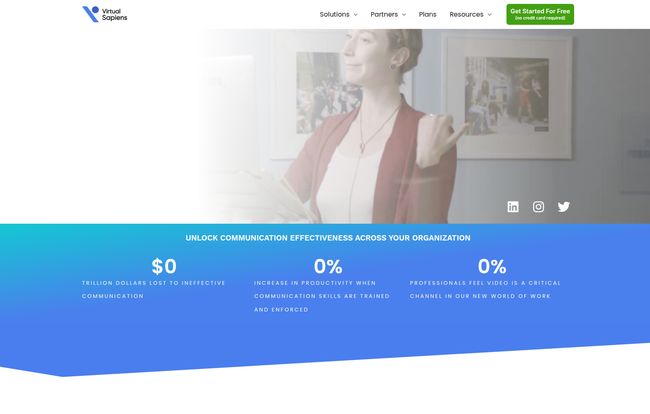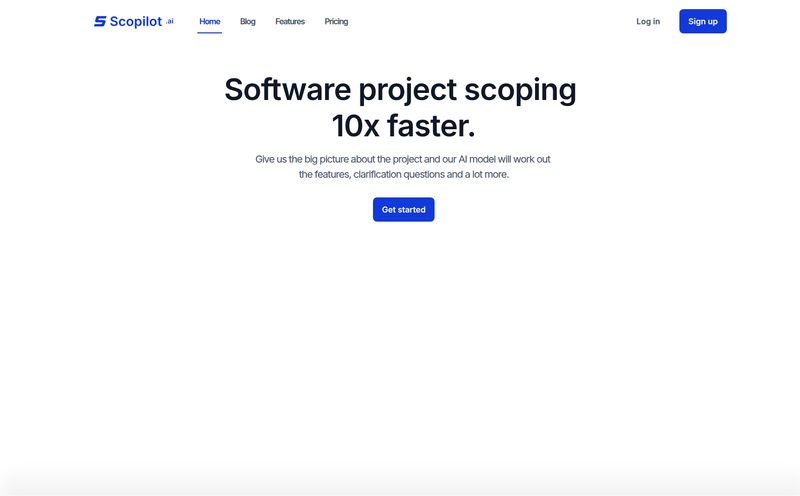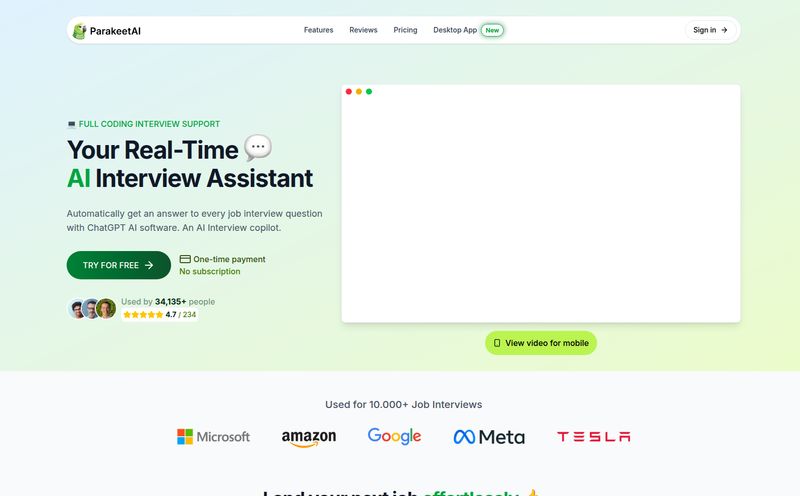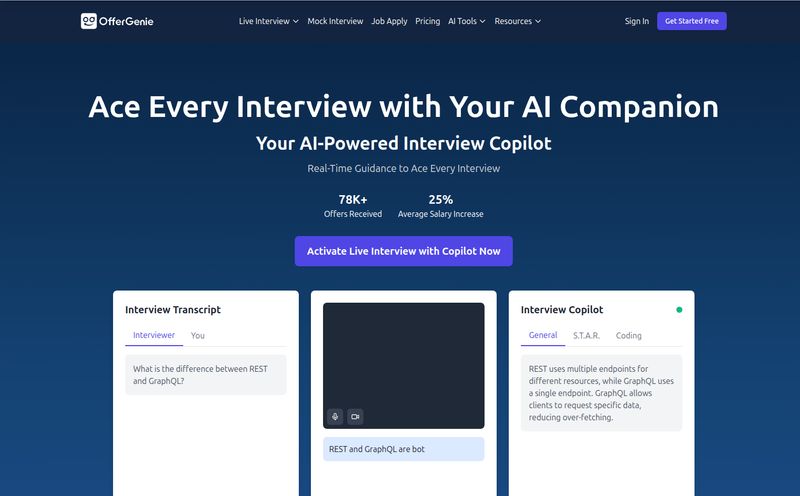We’ve all been there. You’re in the middle of a crucial client call on Zoom, and you catch a glimpse of your own face in that little box. Your eyes are darting around. Are you talking too fast? Did that joke land or just echo into the digital void? You finish the call feeling… unsure. Effective communication in person is hard enough, but on video? It’s a whole different beast.
For years, the gold standard for improving was Toastmasters or hiring a pricey speaking coach. Great options, but not exactly scalable or available for a quick pre-call pep talk. But now, we're in the age of AI, and tools are popping up that promise to be our personal, on-demand digital coaches. One that’s been making some noise is Virtual Sapiens.
The name itself is intriguing, right? It promises to make us better, more effective “virtual” humans. I've spent years watching trends in traffic and tech, and believe me, AI-powered professional development is a space that's about to explode. So, I decided to take a closer look. Is this just another piece of software, or is it a genuinely useful ally in our new world of work?
So, What Exactly Is Virtual Sapiens?
Let's get one thing straight: this isn't another meeting platform. Thank goodness. We don't need another one of those. Instead, Virtual Sapiens is an AI-powered coach that integrates with the platforms you already use, like Zoom, Google Meet, and Microsoft Teams. Think of it less like a new tool and more like a smart layer on top of your existing workflow.
At its core, it uses behavioral AI to analyze your communication skills in real-time. We’re talking about the holy trinity of presence: your nonverbal cues (like eye contact and body language), your vocal tone (are you monotone or engaging?), and your verbal tics (the endless “ums,” “ahs,” and “you knows”). It’s like having a communication expert sitting on your shoulder, whispering feedback, but without the awkwardness of an actual person watching your every move.
It’s designed to spot your blindspots—the things you do without even realizing it. The stuff your polite colleagues would never tell you. It’s a private coach for the digital age, built on behavioral science to help you command a room, even when that “room” is a grid of faces on a screen.

Visit Virtual Sapiens
The Features That Actually Matter
A long list of features can be overwhelming. So let’s cut through the noise and talk about the parts of Virtual Sapiens that I think make a real difference.
The In-Call "Sidekick" Coach: Your Real-Time Ally
This is probably the most talked-about feature. The “Sidekick” is a small, private panel that gives you live nudges during a call. It might gently prompt you to smile more, make better eye contact with the camera, or slow down your speaking pace. My first thought was, “Wouldn't that be incredibly distracting?” And yeah, some might find it a bit much at first. But from what I gather, it's designed to be subtle. It's not a blaring alarm; it’s a gentle reminder. Over time, these nudges are meant to build better habits, so you eventually don't even need them. There’s also a nifty pre-call check to help you warm up and get your settings right before you go live. A small thing, but it makes a big difference in starting strong.
Practice Makes Perfect with AI Role-Plays
Okay, this is cool. Virtual Sapiens offers AI-driven role-plays and custom simulations. Need to practice a tough sales negotiation or prepare for a difficult conversation with a team member? You can run through it with an AI that responds to you. This is a game-changer. For decades, the only way to practice was with a colleague or in front of a mirror, which never feels quite right. This provides a safe, repeatable space to hone your message and delivery until it feels natural. This is one of those features that seems to be more heavily featured in the team plans, which makes sense for org-wide training.
The Post-Call Report Card: Honest Insights or Digital Judgment?
After your call, you don't just log off and forget about it. Virtual Sapiens generates a Post-Call Summary Report Card. It breaks down your performance across various metrics—filler word usage, pace, engagement, you name it. For some, this might feel a little like getting a grade on your personality. But if you can get past that, the data is incredibly valuable. It turns a subjective feeling (“I think that went well?”) into objective data you can act on. Paired with weekly email digests and progress tracking, it creates a feedback loop that’s essential for genuine improvement.
My Honest Take: The Good, The Bad, and The "It Depends"
No tool is perfect, and what works for a massive sales team might not be right for a solo consultant. So let’s get into the nitty-gritty. I’ve always felt that the most important part of any review is the unvarnished truth.
The best thing, in my opinion, is the privacy-first approach. In an era where we're all (rightfully) a bit paranoid about our data, Virtual Sapiens processes video on your local machine. Your face and voice aren't being uploaded to some mysterious cloud server for analysis. This is a huge selling point and shows a real understanding of user concerns.
The feedback is also deeply personalized. It’s not generic advice from a blog post; it’s tailored to your specific habits. I also love that it's backed by communication experts—you can feel teh intention behind the features. It’s not just tech for tech's sake.
Now, for the reality check. This isn't a magic pill. The platform's own materials suggest that improvement requires consistent use. You can’t use it once and expect to transform into a world-class orator. Like going to the gym, you have to put in the reps. Also, some of the most powerful features, like the advanced AI role-plays and detailed team analytics, are reserved for the team plans. That’s a pretty standard SaaS model, but it’s something for individuals to be aware of.
Let's Talk Money: Virtual Sapiens Pricing
So, what does it cost to get this AI coach in your corner? The pricing structure is broken down into a few tiers, which is pretty typical.
- Free Trial: This is your entry point. It seems to give you access to a limited number of assessments and basic metrics. It’s a great way to see if you even like the interface and the kind of feedback it provides before committing. No credit card required, which is always a plus.
- For Individuals: Based on the info, there is a dedicated plan for solo users. This gets you the core experience: the Virtual Presence Assessment, access to the in-call Sidekick coach, and the pre-call check. It's the essentials for personal improvement.
- For Teams: This is where it gets more powerful for organizations. You get everything from the individual plan, plus multi-user engagement metrics, post-call team insights, a manager's dashboard to track overall progress, and access to those slick AI role-play scenarios. This is clearly aimed at sales, HR, and L&D departments.
- Enterprise: For the big dogs. This tier includes everything in Teams, plus custom integrations, single sign-on (SSO), API access, and even white-labeling. Think large corporations looking to integrate this into their existing training ecosystems.
For the most current details and specific numbers, you’re best off checking their official pricing page directly.
Who Should Actually Use Virtual Sapiens?
After looking at everything, a clear picture emerges of the ideal user. If you are in a client-facing role—think sales, business development, or customer success—this tool could be incredibly valuable. The ability to practice pitches and get real-time feedback on your delivery is a direct line to better performance. Just look at the testimonials from folks at Google and HubSpot; they’re not messing around.
Content is what you say. The term is how what you say is presented. Even the best message is devalued if content and term are not aligned. Virtual Sapiens provides real-time feedback to enable me to better align the two...
- David Puig, Director, Google
Managers who want to provide better, data-driven coaching for their teams would also find the dashboards super useful. It's a way to scale coaching without having to sit in on every single call.
Who isn’t it for? If you only hop on a video call once a month or you're looking for a completely free, all-features-unlocked tool, this probably isn't the one. It’s a professional tool for people serious about improving a critical professional skill.
In the end, tools like Virtual Sapiens represent a fascinating shift in professional development. It’s about making coaching more accessible, data-driven, and private. It's not about turning us into perfectly polished robots, but about making us more aware. And in communication, awareness is more than half the battle. It's the first step to true presence.
Frequently Asked Questions (FAQ)
- How does Virtual Sapiens ensure my privacy?
- This is a big one. Virtual Sapiens processes your video and audio data locally on your own computer. The analysis happens in real-time on your device, and your call content is not sent to their servers, which is a major plus for privacy and security.
- What video platforms does it work with?
- It's designed to work as an overlay on top of the most popular platforms. This includes Zoom, Microsoft Teams, and Google Meet, covering the vast majority of business use cases.
- Is there a free version of Virtual Sapiens?
- There is a Free Trial that allows you to test out the core functionality, including getting a limited number of assessments. This lets you get a feel for the platform before deciding on a paid plan for individuals or teams.
- Can I use this for practicing presentations?
- Absolutely. The AI Role-Play and simulation features are perfect for this. You can upload a presentation and practice your delivery, getting feedback on your pace, tone, and body language in a safe, private environment.
- Will this make me sound like a robot?
- That's a valid concern! The goal isn't to make everyone communicate in the exact same way. It's about highlighting your personal blindspots (like overusing filler words) so you can communicate more clearly and authentically. The aim is to enhance your natural style, not replace it.
- How long does it take to see results?
- Improvement is gradual and depends on consistent use. It's not an overnight fix. By using the real-time nudges and reviewing your post-call reports, you build better habits over weeks and months, leading to lasting change.



